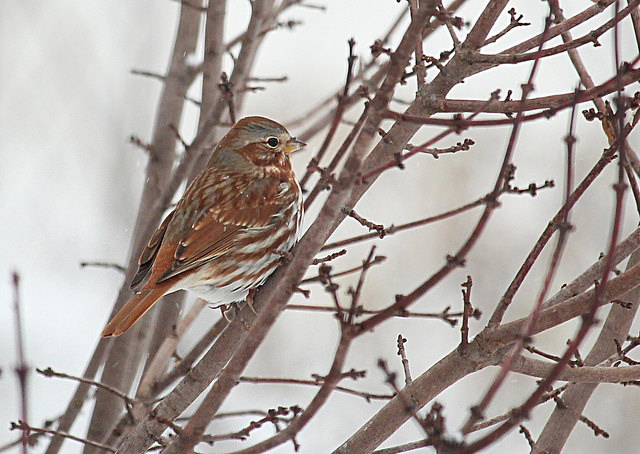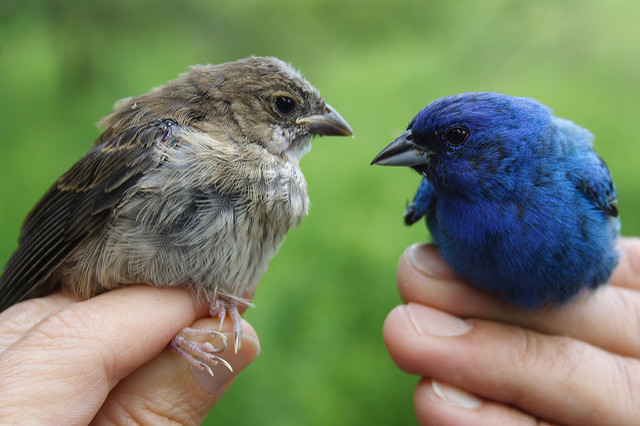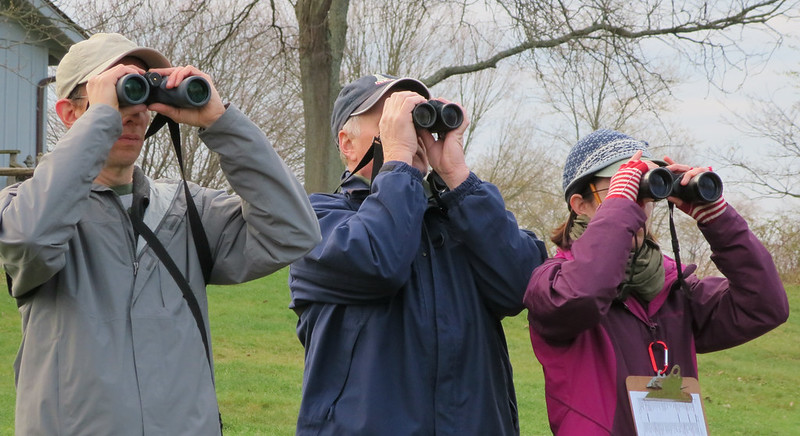By Katie Finch
At Audubon Community Nature Center (ACNC), people think we are all about birds. It is understandable. It was the outrage over the killing of millions of birds to decorate ladies’ hats that led to the foundation of the Massachusetts Audubon Society in 1896. Today, National Audubon Society does research, sets policy, and conserves habitat for birds and other wildlife.
If you have been to a program or just look at the other programs Audubon offers, that myth is quickly dispelled. ACNC works to connect people to all of nature: mammals, insects, plants, the fascinating-yet-complicated systems to which they belong, and also birds.
However, it is difficult not to talk about birds at this time of year. Familiar species are coming back after having been thousands of miles south this winter. Their songs accompany our waking and walking. And they are putting on the most beautiful displays of plumage in the hopes of attracting a mate.
I admit, at the start of a career in outdoor education that looking for something small, moving, and most likely brown and far away with people who knew more than me was not on my list of exciting outdoor adventures. However, with more knowledge, maturity, and generous help from birders I’ve met here, I’ve grown to appreciate and want to know our feathered friends.

Partly as an explanation for those unconverted friends and family members who observe my growing obsession, I’ve starting to think about why people bird.
Birding is a very accessible recreational activity. According to the U.S. Census, 52 million people feed and observe birds. And there are multiple levels in which to participate. You can watch birds in the comfort of your house, appreciating their colors and their antics at the feeder. Or you can learn to identify them: large, distinct ones first and small, nondescript ones later. You can make a list, count them, learn their songs, understand behavior, look for nests and so much more.
Watching birds is another way to mark the changes of the seasons. The “conk-a-ree” of the Red-Winged Blackbird is a welcome sign of spring. “I saw my first bluebird” is the equivalent of saying “Spring is really here.”
Birds are everywhere. There are 914 species of birds in North America. They can be seen in all habitats: swamps, deserts, forests, backyards, and city streets. Walk through many urban areas (including Jamestown and Warren) and listen for the nasal “peent” of Common Nighthawks, which nest on top of city buildings and fly overhead at night hunting insects.
And birds are just beautiful. Think of the bright red of the cardinal or the shining feathers of a hummingbird. Even the invasive European Starling is to be admired in its breeding plumage when caught in the sunlight.
Their stories are also amazing. How many of you have longed to fly like bird? Their endurance of the winter cold and ability to travel thousands of miles is sometimes beyond our ability and understanding. The Arctic Tern travels 25,000 miles from its Arctic breeding grounds to winter off Antarctica.
If you’d like to know more about birds, whether you are a beginner or an expert, ACNC has some opportunities coming up this spring.
Join ornithologists on Saturday mornings, weather permitting, beginning at the end of April. Watch how they capture migrating and resident birds, fit them with identification bands, measure and weigh them, then release them.

Bird banding is an age-old technique used to discover details about the lives of birds. You can drop in any time between 7:00am and 11:00am on four Saturdays from April 29 through May 19 to learn from the ornithologists exactly how it is done and why.
Another option is to join or support birders at Audubon’s birdathon from April 29 through May 8. This is a weeklong event in which birders try to find as many species of birds as possible. Join the Education staff team or create your own to raise money for Audubon while pursuing birds.
Or make a pledge to support the team. The Fledgling team raises money for the Ryan Exline Memorial Scholarship for a college student heading off to college with an interest in pursuing the natural sciences. Generous supporters pledge an amount – either per species or in total – and the end result is the $500 scholarship, with whatever money is raised beyond the scholarship going to rehabilitate the aviary at Audubon that Liberty the Bald Eagle lived in for 20 years. A lot has changed and a lot has been learned since the aviary was built, and Audubon is excited to revamp the aviary to prepare it for new residents.
This scholarship is named in memory of one of the very first recipients of the scholarship. Ryan Exline was a volunteer, intern, nature-lover, and was attending graduate school at Duke University. His love of nature and of nurturing future generations of “nature nerds” lives on in this scholarship.
So as we continue to teach- and learn- about birds and the rest of the amazing outside world, maybe we’ll see you out there.
Audubon Community Nature Center builds and nurtures connections between people and nature. ACNC is located just east of Route 62 between Warren and Jamestown. The trails are open from dawn to dusk and birds of prey can be viewed anytime the trails are open. The Nature Center is open from 10 a.m. until 4:30 p.m. daily except Sunday when it opens at 1 p.m. More information can be found online at auduboncnc.org or by calling (716) 569-2345.
Katie Finch is a Nature Educator at Audubon Community Nature Center


Recent Comments